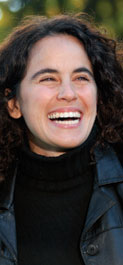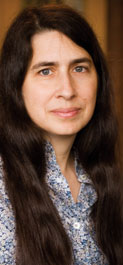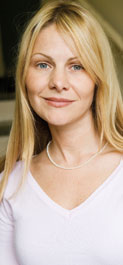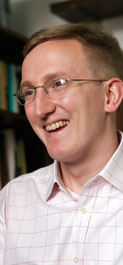English translation: Fresh Faces in the Faculties
English translation: Fresh Faces in the Faculties McGill University
User Tools (skip):
Fresh Faces in the Faculties
Elena Bennett
by Neale McDevitt

Epiphanies can be funny things because you're never quite sure when or where you're going to have one. Take Elena Bennett, a new professor in Natural Resource Sciences and the McGill School of Environment - she had hers during a class on lakes and society.
As a graduate student in Madison, Wisconsin, Bennett was thinking about doing her master's in environmental history. She signed up for the fateful class more because she was trying to track down a friend who might be in attendance than out of any burning desire to help the world. She left the class a changed woman.
"The professor, Steve Carpenter, gave the most amazing lecture I had ever heard," she remembers. "Right there I decided I was going into ecology." She hasn't looked back since.
Completing her master's, Bennett was contemplating environmental management work for her PhD when Carpenter, who had become her advisor, convinced her instead to beef up her credentials by doing some hard science. Bennett decided on the field of soil sampling. "While everyone else in my lab was canoeing out to the middle of the most beautiful lakes in Northern Wisconsin to take water samples, I was driving around suburban Madison digging holes in people's lawns," she says with a laugh.
Not glamorous, maybe, but immediately useful. Data from Bennett's dissertation played an integral role in the successful movement to ban the use of phosphorus-based lawn fertilizers that were leaching into the water table and contaminating local lakes.
Bennett came to McGill after coming across an ad that she says "had the weirdest set of requests: terrestrial-aquatic linkage, expertise in soil and nutrients and some environmental stuff. I sat there thinking 'there's only one person in the world who does that particular set of random things - me!'"
She plans to continue her research in managing ecosystem services, especially when there are trade-offs. "Agriculture has serious effects on our water," Bennett says. "To grow more food we use more fertilizer, and the nutrients from that fertilizer run off into the water and lower its quality. Most of the ways we get food impair water quality and, in the end, we have to spend so much money to treat it to make it drinkable."
Bennett believes that one of the biggest mistakes officials make when managing ecosystems is focusing on one or two aspects and not the whole system. She points to a situation in Quebec as a case in point.
"The provincial government came up with a law in which farmers had to balance their nutrient 'budget'," she explains. "They had to figure out how much phosphorus they were taking off the land - like slaughtered pigs or harvested corn - and that's how much they could put back. Basically, they could only replenish what they took off. Great plan, right? Except once farmers reached their limit, they started cutting down the forests on their land to boost their input again. Whenever you take an action, you have to take a step back and look at how it will affect the whole system."
She's enthusiastic about her move to Montreal. "There are so many young, dynamic ecologists here at McGill - there's a buzz in the air," she smiles. "And my students are great, they are so bright and engaged. I'm happy to be able to teach them more than just a bunch of facts. Hey, this is a living, breathing science."
Jody Heymann
by Mark Reynolds

Health care is a perennial concern in Canada, subject to royal commissions, Supreme Court decisions, elections debates and countless gallons of ink spilt on the opinion pages of the country's newspapers.
Jody Heymann, Canada Research Chair in Global Health and Social Policy, seems likely to become an important voice in this dialogue. As Founding Director of McGill's Institute for Health and Social Policy, Heymann brings a global approach that she honed as Director of Policy at the Harvard Center for Society and Health.
Using comparative data from more than a hundred countries, Heymann seeks to analyze how social conditions - poverty, labour trends and urbanization, for example - affect the health of families, especially children. The research network she has established involves a team of academics operating all around the world, and the work hasn't stopped with her move to Montreal.
"It's tremendously exciting to be at McGill," says Heymann, who arrived last August. "We're focusing on social conditions and how social policy impacts health. McGill brings enormous strength in both social and health sciences to this endeavour."
A medical doctor herself, Heymann has a long publication record in the field, including Global Inequalities at Work: Work's Impact on the Health of Individuals, Families and Societies and the provocatively titled Can Working Families Ever Win?
Global trends like increasing involvement in the workforce and urbanization will be joined in Heymann's research by the policy ramifications of the AIDS pandemic and AIDS orphans in developing countries.
The value of comparing data from so many countries might not seem obvious at first: Sweden does not face the AIDS rates or poverty of a country like Nigeria, nor does Peru have the resources of Norway to implement a cradle-to-grave social safety net. Nonetheless, increasing globalization makes health care and social policies more and more relevant to decision-makers, as multilateral trade and labour mobility agreements mean that the employment and health practices of one country can have a real effect on another.
"In the United States the argument is always made that in a globalizing world they need to remain competitive. They can't afford things like paid sick leave or paid maternity leave because it isn't economically viable. But in our research we found that of the 168 countries we looked at, 165 have some form of paid maternity leave.
"There are always lessons to be learned," says Heymann.
Catherine Limperopoulos
by Neale McDevitt

As a health care professional who was lured away from the U.S. to work at McGill, Catherine Limperopoulos is completing a journey perfect in its circular symmetry.
The newly minted Canada Research Chair (CRC) in Brain and Development is a native Montrealer who did all her studies at McGill, including a PhD in research science. From there she pursued her post-doctoral work at Boston's Children's Hospital, where she participated in cutting-edge research using advanced magnetic resonance imaging (MRI) technology to study babies at high risk for brain injury, like preemies and babies who suffer a lack of oxygen at the time of delivery. In particular, Limperopoulos is interested in the causes of injury and the consequences on subsequent development.
The technology is so advanced that there is nothing comparable in Canada. Not for long. Limperopoulos was invited to come back and help her alma mater set up a similar program at the Montreal Children's Hospital and she jumped at the chance. "I knew it would be a challenge because this will be unique in Canada," says the new addition to Neurology and Neurosurgery and the School of Physical and Occupational Therapy. "But I'm glad to be able to bring it home and make it accessible to others."
The next few months will be spent acquiring and setting up the necessary equipment. On top of the CRC, Limperopoulos won an equipment grant from the Canada Foundation for Innovation. "These funds will enable us to upgrade our scanner and set up an infrastructure like that in Boston," she says.
"From there, the idea is to use quantitative MRI techniques to measure and study brain injury in these children and to evaluate both the process of injury and the recovery time," she continues. The technology will give researchers the ability to establish concrete measurements quantifying brain growth in healthy babies for use as the baseline against which to compare children with brain injuries.
As well, the technology provides an objective way of evaluating various types of therapeutic and rehabilitation approaches. "By using the MRI before we initiate therapy, and again after a defined period of time using a targeted rehab technique, we'll be able to measure its effectiveness in terms of how the brain is wiring," she explains.
Like the events that led her away from and then back to McGill, Limperopoulos's research path has come full circle. Her doctoral training at McGill focused primarily on following high-risk infants and monitoring what happened to them over time. "I started looking at the consequences of brain injury, but now I'm trying to go to the very beginning and study the causes." The long-term goal is to gain a better grasp of how and why injuries occur in order to prevent, or at least minimize the damage.
Age is the biggest advantage for these tiny patients. "An injury at such an early stage is so traumatic, but the amazing thing about babies is that their system has plasticity and is capable of reorganizing itself."
Tom Mole
by Maeve Haldane

In high school, Tom Mole carried about Byron's "Don Juan" like a dandy's gold-topped cane. "I thought it was the funniest, most brilliantly written poem I'd ever come across," says Mole, in his office in the Department of English.
The London-born Mole, the first in his family to go to university, always assumed he'd study Lord Byron (1788-1824) in depth, but it wasn't until his graduate studies at the University of Bristol that he seriously cracked the book spines of the Romantic-era wit. A more mature look at the poet led Mole to think less about Byron's product and more about the product of Byron.
Byron enjoyed an unprecedented celebrity and fame, previously the domain of those who did great deeds, had high social standing, and were, uh, dead. "Real fame was thought to be posthumous fame," says Mole, but Byron was rock-star popular while he was alive - his poem "The Corsair" sold 10,000 copies in one day.
A range of emerging social factors and technologies set up the conditions for Byron's celebrity. There was increasing literacy among the masses - who were sufficiently leisured and sufficiently moneyed to buy and read poems - and a better infrastructure for getting books and pictures to people.
As well, his image was marketed vigorously, Mole says, thanks to the portraits Byron commissioned. "They circulated widely in engravings, and every time they're engraved - there's no copyright - they change a little bit. Then they start to appear in caricatures and other kinds of graphic satire." It didn't take long for pictures that portrayed Byron with an open collar and curling forelock to circulate widely.
Unlike a commissioned painting, anyone can buy an engraved image to possess and "consume" in the privacy of their own home. "What's key to Byron's celebrity is the intimacy his readers feel," Mole says. "When you're reading a Byron poem, looking at a Byron picture, reading a biographical sketch in the paper, when you're consuming Byron's celebrity image, it feels like you're having a kind of relationship with the poet."
Byron had a knack for always seeming to reveal something about himself in his work, in a veiled dance of reveal and conceal, Mole says. "He always left the reader something to imagine. And he could always write another poem that could reveal a little bit more - it kept readers coming back."
Byron was merely one part of a celebrity-making machine, says Mole. "It's about Byron, his publisher, newspaper journalists, artists, engravers, caricaturists, printers, magazine publishers - a whole cultural apparatus."
Now that Mole is happily settled in to the "vibrant university culture" at McGill, he wants to tackle the history of celebrity, using Byron as the first case study.
"We're obsessed with celebrity," he says, citing the global success of TV's American Idol and its knock-offs, which purport to uncover people's inner brilliance or manufacture them into stars. "Celebrity culture has an investment in us not thinking about it, remaining mystified. As long as we attribute the public profile of an individual to their talent or innate star quality, celebrity culture continues to work untrammeled. Only by thinking of the history will we be able to engage critically with celebrity culture now."


